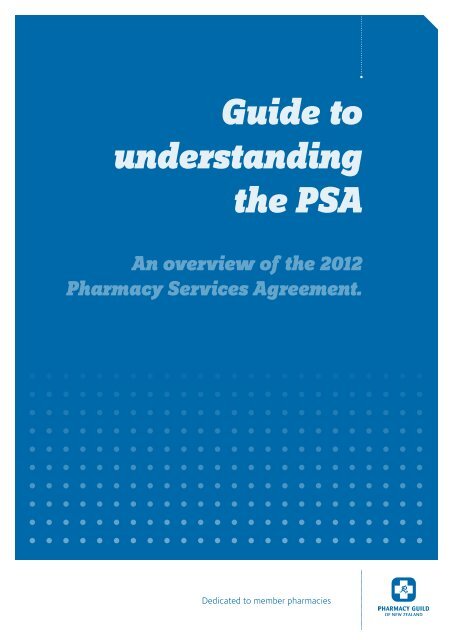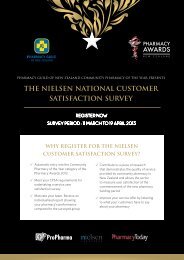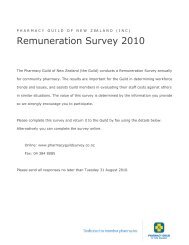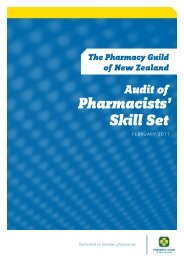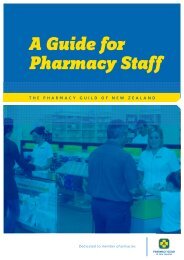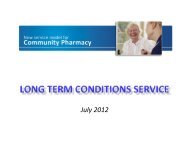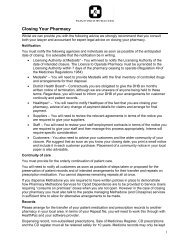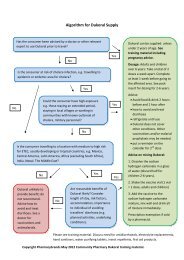Guide to understanding the PSA - Pharmacy Guild of New Zealand
Guide to understanding the PSA - Pharmacy Guild of New Zealand
Guide to understanding the PSA - Pharmacy Guild of New Zealand
Create successful ePaper yourself
Turn your PDF publications into a flip-book with our unique Google optimized e-Paper software.
<strong>Guide</strong> <strong>to</strong><strong>understanding</strong><strong>the</strong> <strong>PSA</strong>An overview <strong>of</strong> <strong>the</strong> 2012<strong>Pharmacy</strong> Services Agreement.Dedicated <strong>to</strong> member pharmacies
This guide presents an overview <strong>of</strong> <strong>the</strong> 2012 Community <strong>Pharmacy</strong> Services Agreement (<strong>the</strong> <strong>PSA</strong> or <strong>the</strong>Agreement). It explains in broad terms each part <strong>of</strong> <strong>the</strong> <strong>PSA</strong>. There is an emphasis on aspects <strong>of</strong> <strong>the</strong> Agreementthat are different from <strong>the</strong> previous one. Particular points <strong>of</strong> note are also highlighted. The guide is best readin conjunction with a copy <strong>of</strong> <strong>the</strong> Agreement. The <strong>PSA</strong> should be read in full for a complete <strong>understanding</strong> <strong>of</strong>contrac<strong>to</strong>rs’ rights and obligations. At <strong>the</strong> end <strong>of</strong> this guide you will find a list <strong>of</strong> <strong>the</strong> acronyms and abbreviationsused in this document.Overview <strong>of</strong> Parts – in order <strong>of</strong> appearance.These Parts and Schedules (*) appear in full after Schedule N1 in this order:• Part C *• Schedule C1 *• Schedule C2 *• Part H *• Schedule H1 *pharmacy guild <strong>of</strong> new zealand
<strong>Guide</strong> <strong>to</strong> <strong>understanding</strong> <strong>the</strong> PsaPart A:<strong>Guide</strong> <strong>to</strong> this AgreementPart A is an introduction and overview <strong>of</strong> <strong>the</strong>Agreement as a whole. It is not legally binding. Itstates <strong>the</strong> parties’ fundamental responsibilities whichare respectively <strong>to</strong> fund, and <strong>to</strong> provide, pharmacyservices <strong>to</strong> Eligible Persons according <strong>to</strong> <strong>the</strong> terms<strong>of</strong> <strong>the</strong> Agreement (A2.1, A2.2). Aspects <strong>of</strong> <strong>the</strong>Agreement’s structure are explained, for instance:• Parts cover specific <strong>to</strong>pics and <strong>the</strong> firstclauses <strong>of</strong> a Part identify key obligations(A3.1).• Schedules contain more technical orspecialised information on a <strong>to</strong>pic (A3.2).• Part E contains <strong>the</strong> definitions for expressionsthat are identified in <strong>the</strong> Agreement with aninitial capital letter (A2.3).• Part P contains Provider specific terms andconditions that add <strong>to</strong>, or depart from,<strong>the</strong> standard terms, and in <strong>the</strong> event <strong>of</strong> aconflict override any o<strong>the</strong>r provisions in <strong>the</strong>Agreement (A5).Part B:Key terms and execution<strong>of</strong> this AgreementIn this section <strong>the</strong>re is an agreement <strong>to</strong> provide andfund pharmacy services according <strong>to</strong> <strong>the</strong> terms <strong>of</strong> <strong>the</strong><strong>PSA</strong> and four o<strong>the</strong>r documents (B1.1). In any conflictbetween <strong>the</strong> documents’ provisions, priority is givenin <strong>the</strong> following order (B1.2):• Pharmaceutical Schedule (<strong>the</strong> Schedule)• Pharmaceutical Transactions DataSpecification• Long Term Conditions (LTC) <strong>Pharmacy</strong>Services Pro<strong>to</strong>col (LTC Pro<strong>to</strong>col)• <strong>PSA</strong>• Procedures Manual.Through PHARMAC, District Health Boards (DHBs)will supply pharmacies with one hard copy <strong>of</strong> <strong>the</strong>Schedule. Pharmacies agree <strong>to</strong> comply with any“refinements” made <strong>to</strong> Services, payment provisions,or <strong>the</strong> LTC Pro<strong>to</strong>col during <strong>the</strong> transition period,by <strong>the</strong> Community <strong>Pharmacy</strong> Services GovernanceGroup (CPSGG) or <strong>the</strong> Community <strong>Pharmacy</strong>Services Operational Group (CPSOG) (B1.5). Part Balso sets out <strong>the</strong> commencement (1 July 2012) andtermination (30 June 2012) dates (B2) and records <strong>the</strong>parties’ signatures (B3).Page 1
Part C:Summary <strong>of</strong> Services <strong>to</strong> beprovidedAppears in full after Schedule N1.Part D:General purposes,principles (and Statements<strong>of</strong> Purpose Covering <strong>the</strong>three year transition <strong>of</strong>this Agreement)This Part aims <strong>to</strong> clarify <strong>the</strong> intentions andcommitment <strong>of</strong> <strong>the</strong> parties in order <strong>to</strong> assist withinterpreting and implementing <strong>the</strong> <strong>PSA</strong>’s provisions.The broad purposes are <strong>to</strong> establish a workingrelationship between <strong>the</strong> parties that, within <strong>the</strong>funding envelope for community pharmacy services,allows improvements in <strong>the</strong> health <strong>of</strong> Eligible Peopleas “contemplated” by <strong>the</strong> <strong>New</strong> <strong>Zealand</strong> Public Healthand Disability Act 2000 (D2). The Part lists Servicedelivery principles, such as providing equity <strong>of</strong> access<strong>to</strong> evidence-based, comprehensive, quality andpr<strong>of</strong>essional standard services. There is <strong>to</strong> be userchoice and <strong>the</strong> aim <strong>of</strong> equity <strong>of</strong> outcomes (D3).The Relationship principles say that <strong>the</strong> parties shouldact in an open and transparent manner, and foster along term co-operative and collaborative relationship.This relationship should adhere <strong>to</strong> <strong>the</strong> principle <strong>of</strong>good faith, and good faith negotiations should takeplace within reasonable and set time frames (D4).Part D contains several new Statements <strong>of</strong> Purpose(D5). This is because <strong>the</strong> new <strong>PSA</strong> radically changes<strong>the</strong> pharmacy services delivery model and because<strong>the</strong>re are associated uncertainties during <strong>the</strong>transition period. The Statements concern:1. Risk sharing.The fixed Annual Funding Envelope (<strong>the</strong> Envelope)poses risks <strong>to</strong> one or <strong>the</strong> o<strong>the</strong>r party when <strong>the</strong>quantity <strong>of</strong> pharmacy services being supplied,and paid for, ei<strong>the</strong>r increases or decreases. If itincreases, pharmacies receive less funding peraverage unit <strong>of</strong> activity. If it decreases, <strong>the</strong> DHBspay more for <strong>the</strong> average unit <strong>of</strong> activity. Thisstatement recognises those risks. The unit <strong>of</strong>pharmacy guild <strong>of</strong> new zealandPage 2
<strong>Guide</strong> <strong>to</strong> <strong>understanding</strong> <strong>the</strong> Psawork that will be used <strong>to</strong> measure <strong>the</strong> quantity <strong>of</strong>pharmacy services delivered is initial prescriptionitems which are /0 and /1 dispensings <strong>of</strong> aprescription. The start point is <strong>the</strong> actual number<strong>of</strong> initial items in <strong>the</strong> year <strong>to</strong> 30 June 2012. If<strong>the</strong>re is more than a 5% annual cumulativeincrease in initial items, <strong>the</strong> size <strong>of</strong> <strong>the</strong> Envelopewill be reviewed as per Part H23.3. If initial itemsdecrease <strong>to</strong> a point lower than <strong>the</strong> start point, areview will determine what additional pharmacyservices could be funded from <strong>the</strong> Envelope. Thestatement contains several expectations, suchas 2.5% annual growth in initial items due <strong>to</strong>demographic changes, a five million decrease inrepeats, that <strong>the</strong> DHBs and pharmacies will takereasonable steps <strong>to</strong> avoid triggering a review, andthat changes <strong>to</strong> <strong>the</strong> funding Envelope will be fairand reasonable.2. Ensuring <strong>the</strong> dispensing ratio is fairer.Higher dispensing ratios increase <strong>the</strong> TransitionPayment per initial prescription item and couldlead <strong>to</strong> unfair, unintended consequences. Highratios (over 2.5), or those that have grown <strong>the</strong>most in <strong>the</strong> past four years, will be reviewed by 1Oc<strong>to</strong>ber 2012.3. Ensuring a balance between <strong>the</strong> servicefee levels within <strong>the</strong> funding Envelope.Because <strong>the</strong> size <strong>of</strong> <strong>the</strong> Envelope is fixed, excessspending on one service reduces funding foro<strong>the</strong>rs.• There are commitments <strong>to</strong> keep <strong>the</strong> Core<strong>Pharmacy</strong> Services (Core Services) ServiceFee (Fee) (Core Service Fee + Handlingfee + Transition Payment) consistent with<strong>the</strong> previous $5.30 dispensing fee and <strong>to</strong>maintain a balance in <strong>the</strong> Envelope with <strong>the</strong>LTC Fee.• Maximum funding levels for Community<strong>Pharmacy</strong> Anti-coagulation Management(CPAM) Services are set at:– 2012/13: $1.5 million– 2013/14: $2.5 million– 2014/15: $3.5 million.• Quality: The Quality Incentive Payment thatwill be paid from 1 February 2013 is set at amaximum 5% <strong>of</strong> <strong>the</strong> Envelope.• Brandswitch: Any unspent funding remainsin <strong>the</strong> Envelope for reallocation throughTransition Payments.• <strong>New</strong> Services: These will only be paid from<strong>the</strong> Envelope if <strong>the</strong>y are in replacement <strong>of</strong>a previously funded service or if <strong>the</strong>y areincluded as a result <strong>of</strong> a D5.1 review, or ifnew funding is introduced in<strong>to</strong> <strong>the</strong> Envelope.4. Ensuring that high LTC registrations donot impact on <strong>the</strong> balance <strong>of</strong> funding <strong>to</strong>Core Services or compromise LTC Servicedelivery.Because <strong>the</strong>ir patient population means <strong>the</strong>yare unable <strong>to</strong> register sufficient LTC patients <strong>to</strong>maintain <strong>the</strong>ir income, some pharmacies willbecome reliant on Core Service Fees. CPSOGis charged with moni<strong>to</strong>ring LTC <strong>Pharmacy</strong>Services (LTC Services) registrations – both <strong>to</strong>maintain <strong>the</strong> balance <strong>of</strong> spending within <strong>the</strong>Envelope and <strong>to</strong> ensure that registrations are <strong>of</strong>patients who will “significantly benefit” from<strong>the</strong> services. It is expected that no more than200,000 Service Users will significantly benefitfrom LTC Services (Statement D5.1). When LTCregistrations are forecast <strong>to</strong> exceed 150,000,CPSOG must actively review <strong>the</strong> LTC ServiceEligibility Assessment Form (<strong>the</strong> LTC EligibilityForm) including <strong>the</strong> threshold for access.5. E-enabling <strong>of</strong> <strong>the</strong> LTC Service EligibilityAssessment Form.The LTC Eligibility Form and “new contract datarequirements (Feb 2013)” are <strong>to</strong> be e-enabledas soon as possible. These electronic systemsmust have been in place for three monthsbefore LTC Service Fees can begin <strong>to</strong> be paid.This e-enablement timing commitment has <strong>the</strong>capacity <strong>to</strong> delay <strong>the</strong> indicative start date <strong>of</strong> 1February 2013 (Part H1.1 (c)) for <strong>the</strong> payment <strong>of</strong>LTC Service Fees. Funding for this e-enablementPage 3
and any multi-disciplinary team sharedinformation platforms, or <strong>the</strong> e-prescribingproject, will come from outside <strong>the</strong> Envelope.6. High risk/Mental Health and Addiction/Disability Service Users.The statement acknowledges that over <strong>the</strong>first seven months <strong>of</strong> <strong>the</strong> <strong>PSA</strong>, <strong>the</strong> TransitionPayments make funding for pharmacy <strong>to</strong> servicethis group relatively stable. During this time,CPSOG will address <strong>the</strong> issue <strong>of</strong> at-risk groupsthat may not be adequately catered for under<strong>the</strong> new <strong>PSA</strong>.7. Audit.This statement <strong>of</strong> purpose acknowledges thatefficient audit is necessary <strong>to</strong> ensure “fundingarrangements are fair and equitable <strong>to</strong> allProviders.” As with any funding model, it wouldbe possible for Providers <strong>to</strong> modify <strong>the</strong>ir practice<strong>to</strong> gain unfairly at o<strong>the</strong>rs’ expense. Examplesmight be <strong>to</strong> register excessive numbers <strong>of</strong> LTCpatients <strong>to</strong> gain additional fees or <strong>to</strong> reducerepeat numbers more than is clinically justified.The whole <strong>PSA</strong> model will be moni<strong>to</strong>red by<strong>the</strong> CPSOG’s Audit Sub-Group for trends, butthree aspects in particular are identified in <strong>the</strong>statement. These are:• LTC registrations• initial script numbers• ratio <strong>of</strong> initial <strong>to</strong> repeat script numbers.The Statement also goes on <strong>to</strong> indicate that animportant part <strong>of</strong> <strong>the</strong> Audit Sub-Group’s role is <strong>to</strong>ensure that “suitably experienced and qualifiedcommunity pharmacy input is available forclinical audits.”8. Role <strong>of</strong> <strong>the</strong> CPSGG and CPSOG.The activities and mandate <strong>of</strong> <strong>the</strong>se committeesare set out and defined in Part I <strong>of</strong> <strong>the</strong>Agreement.9. Evaluation.CPSOG will perform a process and outcomeevaluation.10. Ethical and medico-legal issues.One <strong>of</strong> <strong>the</strong> ways <strong>the</strong> expected reduction in repeatnumbers and <strong>the</strong> management <strong>of</strong> prescriptionvolume (D5.1) will be achieved is by communitypharmacists having powers <strong>to</strong> determine periods<strong>of</strong> supply. The statement indicates that this mustbe achievable within legal requirements.11. Term.Halfway through <strong>the</strong> <strong>PSA</strong>’s three year term <strong>the</strong>DHBs and <strong>Pharmacy</strong> Agents will “review <strong>the</strong>next stage”. There is no fur<strong>the</strong>r elaboration onthis statement within <strong>the</strong> Agreement. The “nextstage” refers <strong>to</strong> <strong>the</strong> period following <strong>the</strong> currentAgreement.pharmacy guild <strong>of</strong> new zealandPage 4
<strong>Guide</strong> <strong>to</strong> <strong>understanding</strong> <strong>the</strong> PsaPart E:Definitions andconstructionThis Part defines wording that is used <strong>to</strong> refer <strong>to</strong><strong>the</strong> parties <strong>to</strong> <strong>the</strong> Agreement. For example, “We”and “our” refers <strong>to</strong> <strong>the</strong> DHB while “You” and“your” refers <strong>to</strong> <strong>the</strong> Provider (E1.2). It clarifies<strong>the</strong> construction <strong>of</strong> some references <strong>to</strong> help <strong>the</strong>interpretation <strong>of</strong> <strong>the</strong> Agreement, for example“notice” periods, exclude <strong>the</strong> day given and include<strong>the</strong> day <strong>of</strong> expiry (E2.1). There is also an alphabeticallist <strong>of</strong> definitions <strong>of</strong> expressions that are usedelsewhere in <strong>the</strong> Agreement and are identified byan initial capital letter (E1.3). Some notable definedexpressions are:Part F:Māori Health and o<strong>the</strong>rpopulation groupsThis Part is largely unchanged from <strong>the</strong> previous<strong>PSA</strong>. While it clarifies that <strong>the</strong>re is no preferentialaccess <strong>to</strong> services on <strong>the</strong> basis <strong>of</strong> race (F1.1), it setsout various commitments <strong>to</strong> address inequalitiesand improve health outcomes in Māori (F2), andany o<strong>the</strong>r priority population groups (F5). There areagreements <strong>to</strong> recognise cultural values (F2), consult(F2) and plan <strong>to</strong> improve service quality (F3).• ARRC Facility, Provider, Service User and<strong>Pharmacy</strong> Services• Consult• Contribution <strong>to</strong> Cost Pressure (CCP). This maybe used in <strong>the</strong> calculation <strong>of</strong> any increase in<strong>the</strong> size <strong>of</strong> <strong>the</strong> funding Envelope• Dispensing• Eligible Person• Handling fee. <strong>Pharmacy</strong> contrac<strong>to</strong>rs wereable <strong>to</strong> cross out <strong>the</strong> second sentence if <strong>the</strong>ydisagreed with it• Long Term Condition, LTC: Access Criteria,Exit Criteria, <strong>Pharmacy</strong> Services, <strong>Pharmacy</strong>Services Pro<strong>to</strong>col, Service Fee Claim andService Patient Eligibility Assessment Form• Market, Market Share• Named Patient Pharmaceutical Assessment(NPPA), Services A and Services B• <strong>Pharmacy</strong> Agent• Records• Specific <strong>Pharmacy</strong> Services (Specific Services)• Transition Payment• Uncontrollable Event.Page 5
Part G:Quality SpecificationsThis Part also remains largely unchanged from <strong>the</strong>previous <strong>PSA</strong>. There is an agreement <strong>to</strong> provideServices that accord with <strong>the</strong> specified QualitySpecifications (G1). Topics covered are quality andquality improvement planning, incorporation <strong>of</strong>Māori perspectives, risk management (Health andSafety, Civil Defence, Health Emergency), ServiceUsers rights, access <strong>to</strong> Services, staff, facilities,Service User surveys, records and administration(G3 - G13).Part H:Payments for Services andPharmaceuticals, claimingprocedure and paymenttermsAppears in full after Schedule N1.pharmacy guild <strong>of</strong> new zealandPage 6
<strong>Guide</strong> <strong>to</strong> <strong>understanding</strong> <strong>the</strong> PsaPart I:Meetings, reporting andinformationAs in <strong>the</strong> previous <strong>PSA</strong>, ei<strong>the</strong>r party may request ameeting <strong>to</strong> discuss <strong>the</strong> contractual relationship, orwider primary care issues (I1.1). The DHB may requesta special meeting that <strong>the</strong> pharmacy contrac<strong>to</strong>rmust make reasonable endeavours <strong>to</strong> attend (I1.2).DHB requested relationship or special meetings maybe held as group meetings (I1.3). In addition, <strong>the</strong>DHBs are still able <strong>to</strong> reasonably require pharmacies<strong>to</strong> supply additional Service related informationwith <strong>the</strong> costs borne by <strong>the</strong> pharmacy (I2). Thebulk <strong>of</strong> this Part sets out <strong>the</strong> constitution androles <strong>of</strong> CPSGG and CPSOG. The CPSGG’s role is <strong>to</strong>oversee implementation <strong>of</strong> <strong>the</strong> new model through<strong>the</strong> transition period, with <strong>the</strong> particular focus <strong>of</strong>ensuring that <strong>the</strong> Statements <strong>of</strong> Purpose in Part Dare upheld. The CPSOG will manage <strong>the</strong> operationalaspects <strong>of</strong> <strong>the</strong> implementation using a range <strong>of</strong> workgroups <strong>to</strong> undertake <strong>the</strong> specific tasks and reviews<strong>of</strong> its work programme. The two groups are <strong>to</strong> workaccording <strong>to</strong> a list <strong>of</strong> principles (I1.4 (c)).Part J:AuditsThe old and <strong>the</strong> new Part J are similar. References <strong>to</strong><strong>the</strong> old <strong>Pharmacy</strong> Advisory Committee have beenremoved and <strong>the</strong> fur<strong>the</strong>r audit purpose <strong>of</strong> examiningLTC assessments and registrations against criteria in<strong>the</strong> LTC Pro<strong>to</strong>col has been added (J1.1). Pharmacieshave a material obligation <strong>to</strong> co-operate and providereasonable assistance <strong>to</strong> ensure an audit is properlycompleted (J1.3). Failure <strong>to</strong> perform any materialobligation may breach <strong>the</strong> Agreement and allow <strong>the</strong>DHB <strong>to</strong> seek various remedies or termination (O2).Audits should meet <strong>the</strong> principles and follow <strong>the</strong>process guidelines set out in Schedule J1 (J1.2).Page 7
Part K:Dispute resolutionThis Part sets out <strong>the</strong> good faith process and methodsby which <strong>the</strong> parties are <strong>to</strong> endeavour <strong>to</strong> resolvecontractual disputes without litigation (K2.3); first byagreement, <strong>the</strong>n arbitration (K2.2). It is largely <strong>the</strong>same as in <strong>the</strong> previous <strong>PSA</strong> but now <strong>the</strong> parties mayagree <strong>to</strong> refer <strong>the</strong> matter <strong>to</strong> <strong>the</strong> CPSOG or CPSGGra<strong>the</strong>r than <strong>the</strong> <strong>Pharmacy</strong> Advisory Committee (K2.1).There is <strong>the</strong> capacity for disputes <strong>to</strong> be resolved at<strong>the</strong> collective level (K2.1 (b)). The dispute resolutionprocesses in K2 do not apply <strong>to</strong> certain disputes,including those relating <strong>to</strong> a review or variation <strong>of</strong>,or negotiation in relation <strong>to</strong>, <strong>the</strong> Agreement (K3.1).If such disputes are not resolved by agreement,ei<strong>the</strong>r party may initiate an independently facilitatednegotiation process (K3.2).Part L:Variation <strong>of</strong> AgreementJust as in <strong>the</strong> previous <strong>PSA</strong>, <strong>the</strong> grounds for variationare classified as ei<strong>the</strong>r voluntary (mutual agreement)or compulsory (Crown direction or law change)(L2.2). Processes are set out for negotiation andagreement, or imposition <strong>of</strong> variations (L3 <strong>to</strong> L6).However, <strong>the</strong>re is an additional Transitional ChangeMechanism (TCM) (L7) <strong>to</strong> support <strong>the</strong> transition <strong>to</strong> <strong>the</strong>new pharmacy funding and service model. The <strong>PSA</strong>has a fixed funding Envelope and transition period.It will be necessary for some Services provided (and<strong>the</strong> associated funding mechanisms) <strong>to</strong> be refinedwhile <strong>the</strong> Agreement is in place (L7.1). In any conflictbetween clauses L2 <strong>to</strong> L6 and <strong>the</strong> provisions <strong>of</strong> <strong>the</strong>TCM, <strong>the</strong> TCM will be applied (L7.4). It is only <strong>the</strong>20-DHB collective or <strong>the</strong> CPSGG that can makeproposals <strong>to</strong> use <strong>the</strong> TCM (L7.2). A proposal canonly be ei<strong>the</strong>r <strong>to</strong> refine <strong>the</strong> nature and scope <strong>of</strong>Services provided in Part C and Schedules C1 and C2,or <strong>to</strong> amend <strong>the</strong> payment provisions in Part H andSchedule H1 (L7.1). The TCM itself is that pharmaciesor <strong>the</strong>ir agents will be presented with proposedchanges <strong>to</strong> Services or payment provisions and <strong>the</strong>nhave 20 days <strong>to</strong> provide feedback (L7.3 (b) (c)). Thefeedback will be considered by CPSGG which willmake a recommendation for endorsement by <strong>the</strong>20-DHB collective (L7.3 (d)). The Agreement willbe deemed <strong>to</strong> be varied and documentation will beprovided <strong>to</strong> pharmacies (L7.3 (e)).pharmacy guild <strong>of</strong> new zealandPage 8
<strong>Guide</strong> <strong>to</strong> <strong>understanding</strong> <strong>the</strong> PsaPart M:Terms governing yourdealings with third partiesThe provisions in this Part, covering subcontracting(M2), liability for o<strong>the</strong>rs (M2), transfer <strong>of</strong> rights/obligations with consent (M4), confidentiality andpublicity (M5), and incentives for prescribers (M6),are <strong>the</strong> same as <strong>the</strong> previous <strong>PSA</strong>. A new clause M1.3prevents pharmacy contrac<strong>to</strong>rs from <strong>of</strong>fering EligiblePersons any gifts, prizes or financial inducements(including waiving Co-payment charges) <strong>to</strong> seekServices from <strong>the</strong> pharmacy. Services means servicesspecified in Part C (E1.3).Part N:O<strong>the</strong>r miscellaneous termsgoverning our relationshipThe provisions in this part covering contrac<strong>to</strong>rindependence (N1), insurance (N2), indemnity (N3),warranty (N4), compliance with law (N5), waiver(N6), entirety (N7), enforceability (N8), third partybenefits (N9), counterparts (N10) and governing law(N11), are <strong>the</strong> same as <strong>the</strong> previous <strong>PSA</strong>. Email and itsdeemed timing <strong>of</strong> receipt has been added <strong>to</strong> <strong>the</strong> lis<strong>to</strong>f means <strong>of</strong> communication (12.3 (d)).Page 9
Part O:Failure <strong>to</strong> perform andtermination <strong>of</strong> AgreementThis Part is largely <strong>the</strong> same as <strong>the</strong> previous <strong>PSA</strong>except that referrals <strong>to</strong> <strong>the</strong> <strong>Pharmacy</strong> AdvisoryCommittee have been replaced with referrals<strong>to</strong> CPSOG or CPSGG. The Part as a whole dealswith remedies that are available <strong>to</strong> <strong>the</strong> parties ifone or <strong>the</strong> o<strong>the</strong>r fails <strong>to</strong> perform its obligationsunder <strong>the</strong> Agreement (O2 and O3). Issues coveredare termination (O4 and O7 - O12), suspension,reinstatement, dispute (O4), alternative arrangements(O5) and uncontrollable events (O6).Part P:Provider specific termsand conditionsThis Part contains any Provider specific terms andconditions that are additional <strong>to</strong>, or depart from,<strong>the</strong> standard terms in <strong>the</strong> rest <strong>of</strong> <strong>the</strong> Agreement.Provisions in Part P arise from negotiation andagreement between <strong>the</strong> pharmacy contrac<strong>to</strong>r and<strong>the</strong> DHB. Local variations that may be dealt with hereare <strong>the</strong> provision <strong>of</strong>, for example, rural or after-hoursservices. In <strong>the</strong> event <strong>of</strong> any conflict, <strong>the</strong> specialterms and conditions that are included in Part Ptake precedence over those found elsewhere in <strong>the</strong>Agreement (P1.2).SchedulesSchedule C1: Service specifications *Appears in full after Schedule N1.Schedule C2: Clozapine DispensingPro<strong>to</strong>cols *Appears in full after Schedule N1.Schedule H1: Payment terms *Appears in full after Schedule N1.Schedule J1: Audit FrameworkThe framework provides general guidelines,principles, processes and time frames for <strong>the</strong> conduc<strong>to</strong>f audits. The terms are <strong>the</strong> same as <strong>the</strong> frameworkin <strong>the</strong> previous <strong>PSA</strong> and it is <strong>to</strong> be read in conjunctionwith Part J (Schedule J1.1).Schedule N1: Bank account detailsThis is where <strong>the</strong> pharmacy provides its bank accountdetails for payment by <strong>the</strong> DHB.pharmacy guild <strong>of</strong> new zealandPage 10
<strong>Guide</strong> <strong>to</strong> <strong>understanding</strong> <strong>the</strong> PsaPart C:Summary <strong>of</strong> Services <strong>to</strong> beprovidedFirst, this Part lists all <strong>of</strong> <strong>the</strong> <strong>Pharmacy</strong> Services thatmay be provided by contrac<strong>to</strong>r pharmacies and willbe publicly funded (C2.1):• Core and LTC Services• Specific Services (Class B Controlled Drug(Class B CD), Aseptic <strong>Pharmacy</strong> (Aseptic),Sterile Manufacturing (Sterile), Special Foods,<strong>Pharmacy</strong> Clozapine (Clozapine), ARRC,CPAM, Extemporaneously CompoundedPreparations (Extemp), NPPA A and B)• O<strong>the</strong>r pharmacy services, if any – Part P.The detailed particulars that each Service consists<strong>of</strong>, are found under <strong>the</strong> name <strong>of</strong> <strong>the</strong> Service inSchedule C1. At C2.2 (a) <strong>the</strong>re is an agreement thatpharmacies will provide and claim for Core Services,unless <strong>the</strong> Service User is eligible for LTC Servicesor a Specific Service (C2.2 (a)). If a Service User isregistered for LTC Services or meets <strong>the</strong> criteria fora Specific Service, <strong>the</strong>n <strong>the</strong> pharmacy will provideand be funded for those Services (C2.2 (b) and (c)).Some Specific Services, such as NPPA A, NPPA Band Extemp, will be funded in every communitypharmacy and are in effect part <strong>of</strong> Core and LTCServices. Some o<strong>the</strong>rs, such as Aseptic, Sterile,Special Foods, Clozapine and CPAM services willonly be funded if <strong>the</strong> Specific Service is found at C2in Schedule C1 in <strong>the</strong> pharmacy’s particular <strong>PSA</strong>.To include an additional Specific Service at C2 inSchedule C1, pharmacies may be required <strong>to</strong> providesufficient information <strong>to</strong> demonstrate <strong>the</strong>ir ability <strong>to</strong>perform <strong>the</strong> Service (C2.3).Part C includes a commitment from both parties<strong>to</strong> work <strong>to</strong>ge<strong>the</strong>r in good faith <strong>to</strong> support <strong>the</strong>transition <strong>to</strong> <strong>the</strong> new model and refine <strong>the</strong> Servicesprovided under <strong>the</strong> Agreement (C2.4). There is alsoan agreement by Providers <strong>to</strong> participate in peerreview <strong>of</strong> Services provided by o<strong>the</strong>r Providers, and<strong>to</strong> work with CPSOG <strong>to</strong> develop audit and peerreview programmes (C2.5). Service User eligibilityis still determined against <strong>the</strong> same legislation, but<strong>the</strong> clause on deciding eligibility <strong>to</strong> receive Serviceshas been expanded (C3.1). The method <strong>to</strong> determineeligibility and <strong>the</strong> entitlement <strong>to</strong> rely on prescribers’information is stated (C3.1 (b) (c)) and a websiteaddress <strong>to</strong> provide guidance is provided (C3.1 (d)).The clauses dealing with disputes (C3.2), providingServices <strong>to</strong> ineligible persons (C3.3) and change<strong>of</strong> Premises (C4.2) remain <strong>the</strong> same. There is stilla restriction on providing services outside <strong>the</strong>DHB’s geographical area but <strong>the</strong> method <strong>to</strong> obtainpermission <strong>to</strong> do so is stated, as is <strong>the</strong> exception for<strong>the</strong> occasional provision <strong>of</strong> Services <strong>to</strong> travellingnon-residents (C4.1 (b)).Schedule C1: Service specificationsCore <strong>Pharmacy</strong> Services – This Service Specificationreplaces “Base <strong>Pharmacy</strong> Services” from <strong>the</strong> previous<strong>PSA</strong> and is characterised by <strong>the</strong> DHBs as being largelyunchanged (C<strong>PSA</strong> 2012 Summary <strong>of</strong> Changes <strong>to</strong><strong>the</strong> Agreement). There are provisions dealing withopening hours (5.2) and waiting times (6.2). Theclause concerning dispensing specific brands reflectsrecent regula<strong>to</strong>ry changes. The prescriber’s consentis no longer required for a pharmacist <strong>to</strong> substitutea generic for a Specific Brand unless “No brandsubstitution permitted” or similar is written (3.2(b)). Core Services include dispensing, advice andcounselling, record keeping, reporting <strong>to</strong> prescribers,administration according <strong>to</strong> <strong>the</strong> Procedures Manual,filling Practitioner Supply Orders (PSO), filling BulkSupply Orders (BSO) and Nicotine ReplacementTherapy (6.1). <strong>Pharmacy</strong> Methadone Services forOpioid Dependence (Methadone Services) areincluded in Core Services if provided on an adhoc or intermittent basis at patients’ request (6.1(i)). Methadone Services must still be provided inaccordance with <strong>the</strong> Service specification but unlessit is listed in clause 2 <strong>of</strong> Schedule C1, you can haveno more than two patients using <strong>the</strong> service at anyone time (6.1 (i) (iii)).Page 11
The Core Service specification commits pharmacies<strong>to</strong> assessing patients, who were formerly on closecontrol under <strong>the</strong> old Pharmaceutical Schedule rule,for LTC Services by 31 January 2013 (6.1 (j)).From <strong>the</strong> indicative date <strong>of</strong> 1 February 2013, everyclaim for payment for Core Services will have <strong>to</strong>include <strong>the</strong> Service User’s NHI number (6.1 (l)).Service Users receiving Core Services may alsoreceive Class B CD, Aseptic, Sterile, Special Foods,Clozapine, CPAM, Extemp, NPPA A and NPPA BServices. Pharmacies will only be able <strong>to</strong> claim forAseptic, Sterile, Special Foods, Clozapine, CPAM andMethadone Services for more than two patients,if <strong>the</strong> relevant service specification is found in clause2 <strong>of</strong> Schedule C1 <strong>of</strong> <strong>the</strong>ir <strong>PSA</strong> (10.1). LTC and ARRC<strong>Pharmacy</strong> Services are excluded from <strong>the</strong> CoreService Specification (8).LTC <strong>Pharmacy</strong> Services – Pharmacies will be paid<strong>to</strong> provide LTC Services <strong>to</strong> Service Users who areeligible under <strong>the</strong> LTC Pro<strong>to</strong>col (1.1). Both partiesacknowledge that <strong>the</strong> LTC Pro<strong>to</strong>col will evolve during<strong>the</strong> term <strong>of</strong> <strong>the</strong> <strong>PSA</strong> (1.3 (a)). The Pro<strong>to</strong>col is outside<strong>the</strong> <strong>PSA</strong> <strong>to</strong> facilitate <strong>the</strong> process for its evolutionarychange. <strong>Pharmacy</strong> contrac<strong>to</strong>rs will be consulted butif <strong>the</strong> LTC Pro<strong>to</strong>col (1.3 (b)) is amended <strong>the</strong>y mustreview <strong>the</strong> status <strong>of</strong> LTC Service Users against Accessand Exit Criteria <strong>to</strong> determine ongoing eligibility(1.3 (c)). Using LTC Access Criteria and <strong>the</strong> LTCPro<strong>to</strong>col, pharmacies are <strong>to</strong> determine Service Usereligibility for <strong>the</strong> appropriate level <strong>of</strong> LTC Servicesin good faith (3.1 (c)). The specifications detailprocesses and requirements for changing Providers(3.2), exiting <strong>the</strong> programme (3.3), record keeping(5.1) and reporting (5.2). 4.1 lists <strong>the</strong> essential LTCservices <strong>to</strong> be provided <strong>to</strong> each Service User,as appropriate.LTC Service Users can receive Class B CD, Aseptic,Sterile, Special Foods, Clozapine, CPAM, Extemp,NPPA A and NPPA B Services (4.5). Pharmacies willonly be able <strong>to</strong> claim for Aseptic, Sterile, SpecialFoods, Clozapine, CPAM and Methadone Servicesfor more than two patients if <strong>the</strong> relevant servicespecification is found in clause 2 <strong>of</strong> Schedule C1 <strong>of</strong><strong>the</strong>ir <strong>PSA</strong> (8).Pharmacies must ensure that LTC Services areprovided <strong>to</strong> a Service User by appropriate staffmembers in accordance with <strong>the</strong>ir scopes <strong>of</strong> practiceand <strong>the</strong> identified needs <strong>of</strong> that Service User (6).Apart from appropriate Specific Services (4.5),pharmacies may not claim for providing any o<strong>the</strong>rServices (Core Services) <strong>to</strong> <strong>the</strong>ir LTC patients (7(a)). Pharmacies are not <strong>to</strong> claim for providing LTCServices <strong>to</strong> people who have not been “approved”(assessed) as eligible for LTC Services or those whoare ARRC Service Users (7 (b)).pharmacy guild <strong>of</strong> new zealandPage 12
<strong>Guide</strong> <strong>to</strong> <strong>understanding</strong> <strong>the</strong> Psa<strong>Pharmacy</strong> Services <strong>to</strong> ARRC Service Users inARRC Facilities – ARRC Service Users qualify“under <strong>the</strong> Social Security Act 1964 as requiringlong-term residential care in a hospital or rest homeindefinitely” and <strong>the</strong>y receive ARRC <strong>Pharmacy</strong>Services from an ARRC Provider in an ARRC Facility(see E1.3 for definitions). O<strong>the</strong>r rest home or longstaycare hospital residents, or o<strong>the</strong>r residents <strong>of</strong>ARRC Facilities, do not qualify for ARRC Servicesunder <strong>the</strong> Agreement (3). ARRC Service componentsinclude dispensing according <strong>to</strong> <strong>the</strong> processoutlined in 6.1 (a) <strong>to</strong> (e) <strong>of</strong> <strong>the</strong> Core Services servicespecification (5.1 (a)). O<strong>the</strong>r aspects <strong>of</strong> <strong>the</strong> ARRCService specification are access (4), information andadvice, pr<strong>of</strong>iling, synchronisation, reconciliation,review, education (5.1), facilities (5.2) and waitingtimes (5.3). All claims for payment for ARRC Servicesmust include <strong>the</strong> Service User’s NHI number and from<strong>the</strong> indicative date <strong>of</strong> 1 February 2013, <strong>the</strong> date <strong>of</strong>birth (5.4). Within one month <strong>of</strong> starting <strong>to</strong> service anARRC facility, <strong>the</strong> pharmacy contrac<strong>to</strong>r must inform<strong>the</strong> DHB in writing <strong>of</strong> <strong>the</strong> name <strong>of</strong> <strong>the</strong> ARRC facility.<strong>Pharmacy</strong> Methadone Services for OpioidDependence (Class B Controlled Drug Services) –These are <strong>the</strong> detailed service specificationsfor pharmacies that regularly dispense methadone(for more than two patients) (5.2 (a)).Next are <strong>the</strong> service specifications for: Aseptic<strong>Pharmacy</strong> Services (including Syringe DriverServices), Sterile Manufacturing Services, SpecialFoods Services, CPAM, <strong>Pharmacy</strong> ClozapineServices. Then, Schedule C2 Clozapine DispensingPro<strong>to</strong>cols.ARRC Service Users can receive Class B CD, Aseptic,Sterile, Special Foods, Clozapine, CPAM, Extemp,NPPA A and NPPA B Services (5.5). Pharmacies willonly be able <strong>to</strong> claim for Aseptic, Sterile, SpecialFoods, Clozapine, CPAM and Methadone Servicesfor more than two patients if <strong>the</strong> relevant servicespecification is found in clause 2 <strong>of</strong> Schedule C1<strong>of</strong> <strong>the</strong>ir <strong>PSA</strong> (10.1).Page 13
Part H:Payments for Services andPharmaceuticals, claimingprocedure and paymenttermsDuring <strong>the</strong> transition, pharmacies will au<strong>to</strong>maticallybe paid a Transition Payment, in advance, on <strong>the</strong>first business day <strong>of</strong> every month (H1.1 (d)). Themethod <strong>of</strong> calculation is found in H22.3. CoreService and LTC Service Fees are not being paid in<strong>the</strong> first stage <strong>of</strong> <strong>the</strong> transition and are due <strong>to</strong> bepaid from <strong>the</strong> indicative date <strong>of</strong> 1 February 2013.Pharmacies will continue <strong>to</strong> make claims for <strong>the</strong> cos<strong>to</strong>f Pharmaceuticals and Handling Fees (H1.1) in <strong>the</strong>same way as <strong>the</strong> previous <strong>PSA</strong>. There are consistentprovisions concerning claim periods (H3.1), timelimits (H9) and time frames (H12).A notable change is found in <strong>the</strong> provisionsconcerning Co-payments at H4.4 (a). During <strong>the</strong>transition, pharmacy contrac<strong>to</strong>rs must charge ServiceUsers <strong>the</strong> full Co-payment with <strong>the</strong> only exceptionbeing in situations <strong>of</strong> hardship when <strong>the</strong> Service Userwould not o<strong>the</strong>rwise collect <strong>the</strong> pharmaceuticals.Pharmacies may still charge product premiums (H4.5)and <strong>the</strong> circumstances when o<strong>the</strong>r pharmacy chargesmay be made are found in H4.6.Despite remaining in <strong>the</strong> text, clause H4.8 –<strong>the</strong> requirement <strong>to</strong> provide a receipt that records<strong>the</strong> cost <strong>to</strong> <strong>the</strong> Government for <strong>the</strong> provision<strong>of</strong> <strong>the</strong> pharmaceutical – has been recognised asproblematic. It is hard <strong>to</strong> calculate this cost <strong>to</strong> <strong>the</strong>Government because, with Transition Paymentsbeing made, much <strong>of</strong> <strong>the</strong> funding is not attached<strong>to</strong> <strong>the</strong> particular pharmaceutical being dispensed.S<strong>of</strong>tware providers have eliminated <strong>the</strong> functionfrom <strong>the</strong>ir programmes but <strong>the</strong> clause remains forfuture application.There are some clarifications about cost and volumeshifting under <strong>the</strong> new model at H6. The <strong>PSA</strong> doesnot allow arrangements that result in paymentsbeing made more than once for <strong>the</strong> provision<strong>of</strong> a prescription item for a Service User (H6.1).A pharmacy claiming for <strong>the</strong> provision <strong>of</strong> CoreServices <strong>to</strong> a Service User already registered as anLTC patient at that pharmacy is given as an example<strong>of</strong> a disallowed arrangement (H6.1 (a)). Ano<strong>the</strong>rdisallowed arrangement is referring an LTC registeredpatient <strong>to</strong> ano<strong>the</strong>r pharmacy <strong>to</strong> receive a CoreService (unless <strong>to</strong> obtain unavailable urgently neededmedication) (H6.2 (b)). Artificially increasing revenueis prohibited (H6.3) and that might cover <strong>the</strong> serialdispensing <strong>of</strong> items <strong>to</strong> a Core Service patient overseveral days <strong>to</strong> obtain multiple payments <strong>of</strong> <strong>the</strong> Coreservice fee (paid per patient, per pharmacy, per day).There are new requirements for <strong>the</strong> submission <strong>of</strong>Service Users’ information. Claims for <strong>the</strong> provision<strong>of</strong> LTC Services and ARRC Services must include <strong>the</strong>patient’s NHI number and from an indicative date <strong>of</strong>1 February 2013, <strong>the</strong> date <strong>of</strong> birth (H7.4). Also from<strong>the</strong> indicative date <strong>of</strong> 1 February 2013, every claimitem (including Core Service) submitted must include<strong>the</strong> Service User’s NHI number (H7.3).The provisions concerning Transition Paymentsbegin at H22. Information about dispensing ratiosis found at H22.2. The dispensing ratio is calculatedby dividing <strong>the</strong> <strong>to</strong>tal number <strong>of</strong> prescription itemsdispensed in <strong>the</strong> 2011 year by <strong>the</strong> number <strong>of</strong> initialprescription items (/0,/1 items) (H22.2 (c)). The ratiois designed <strong>to</strong> distribute transition funds amongall pharmacy contrac<strong>to</strong>rs in a way that maintains<strong>the</strong>ir overall levels <strong>of</strong> funding while <strong>the</strong>y adapt<strong>the</strong>ir business practice <strong>to</strong> <strong>the</strong> new model. A higherratio is attached <strong>to</strong> pharmacies that dispensedgreater numbers <strong>of</strong> repeats per initial prescriptionitem. During <strong>the</strong> early stages <strong>of</strong> <strong>the</strong> transition, allpharmacies will be able <strong>to</strong> keep providing a similarlevel <strong>of</strong> service <strong>to</strong> <strong>the</strong>ir patients and will receive asimilar level <strong>of</strong> funding overall. As <strong>the</strong> transitionprogresses, patient service fees begin <strong>to</strong> be paid soTransition Payments (based on numbers <strong>of</strong> initialprescription items multiplied by <strong>the</strong> dispensingpharmacy guild <strong>of</strong> new zealandPage 14
<strong>Guide</strong> <strong>to</strong> <strong>understanding</strong> <strong>the</strong> Psaratio) will become a less significant proportion <strong>of</strong> apharmacy’s funding. Pharmacies whose income reliedon high numbers <strong>of</strong> repeats will need <strong>to</strong> change<strong>the</strong>ir business practice <strong>to</strong> maintain <strong>the</strong> same level <strong>of</strong>funding. H22.2 also details methods <strong>of</strong> calculationfor dispensing ratios <strong>of</strong> pharmacies in non-standardsituations (H22.2 (c)), <strong>the</strong> Dispensing Ratio Sub-Group’s ability <strong>to</strong> impose a ratio (H22.2 (e)) and <strong>the</strong>appeals process (H22.2 (f), (g) and (h)).The Envelope is split in<strong>to</strong> monthly Transition Pools(H22.1 (b)) and actual Transition Payments are takenfrom that. They are based on forecast numbers<strong>of</strong> pharmacies’ initial prescriptions (<strong>the</strong> /1 or /0dispensing). No Transition Payments are triggeredby repeat dispensings (/2,/3 and so on). A nationaltransition fee is derived ($4.2879 in July 2012) andmultiplied by <strong>the</strong> pharmacy’s dispensing ratio andforecast number <strong>of</strong> initial prescription items <strong>to</strong>calculate <strong>the</strong> actual Transition Payment. In effect,<strong>the</strong> impact <strong>of</strong> <strong>the</strong> dispensing ratio on a TransitionPayment is <strong>to</strong> increase it <strong>to</strong> pre-pay for <strong>the</strong> averagenumber <strong>of</strong> repeats that an initial prescription itemgenerated in 2011 at that pharmacy.Four months after <strong>the</strong> forecast-based TransitionPayment is made, an adjustment is calculated basedon actual prescription numbers dispensed and<strong>the</strong> next Transition Payment adjusted accordingly(H22.3).Clause H23 deals in detail with adjustments <strong>to</strong> <strong>the</strong>size <strong>of</strong> <strong>the</strong> Envelope. From $375.5 million in 2012/13it will remain static or be adjusted upwards annuallyby <strong>the</strong> lesser <strong>of</strong> 1.5% or <strong>the</strong> CCP – see Part E for adefinition (H23.1). The maximum annual fundingfor CPAM is specified and any unspent funds willremain in <strong>the</strong> Envelope (H23.1 (d)). The assumptionsthat have underpinned <strong>the</strong> setting <strong>of</strong> <strong>the</strong> size <strong>of</strong> <strong>the</strong>Envelope are listed (H23.2) as are <strong>the</strong> expectationsabout any review <strong>of</strong> <strong>the</strong> Envelope’s size (H23.3).DHBs and Providers are expected <strong>to</strong> take reasonablesteps <strong>to</strong> avoid triggering a review <strong>of</strong> <strong>the</strong> Envelope(H23.3 (a)). Any review would be conducted by<strong>the</strong> DHBs collectively on <strong>the</strong> recommendation <strong>of</strong><strong>the</strong> CPSGG that will have considered <strong>the</strong> advice <strong>of</strong><strong>the</strong> CPSOG (H23.3 (b)). The precise circumstancesthat would cause a recommendation <strong>to</strong> review<strong>the</strong> size <strong>of</strong> <strong>the</strong> Envelope are found in H23.4.These circumstances are based on growth in <strong>the</strong>numbers <strong>of</strong> initial items dispensed. If <strong>the</strong> 20-DHBcollective decides <strong>to</strong> vary <strong>the</strong> size <strong>of</strong> <strong>the</strong> Envelope,<strong>the</strong> adjustment must be by a fair and reasonableamount (H23.3 (c)) according <strong>to</strong> <strong>the</strong> principles se<strong>to</strong>ut in clause H23.6 (H23.3 (d)). Once <strong>the</strong> DHBs havereached a view on a fair and reasonable adjustment,pharmacy contrac<strong>to</strong>rs will be notified and <strong>the</strong> revisedEnvelope used in <strong>the</strong> calculation <strong>of</strong> fur<strong>the</strong>r TransitionPayments (H23.5 (d)).Schedule H1: Payment termsThis Part begins with <strong>the</strong> provisions that are intended<strong>to</strong> apply <strong>to</strong> payments under <strong>the</strong> <strong>PSA</strong> after <strong>the</strong>transition period is over (clauses 2.2 <strong>to</strong> 2.6). Thetransition will end no earlier than 1 July 2014 (H2.1).Transition Stage 1 is intended <strong>to</strong> be from 1 July 2012<strong>to</strong> 31 January 2013 (3.1). Stage 2 is intended <strong>to</strong> befrom 1 February 2013 <strong>to</strong> 30 June 2013 (3.2) andStage 3 from 1 July 2013 <strong>to</strong> 30 June 2014 (3.3).Throughout <strong>the</strong> entire period <strong>of</strong> <strong>the</strong> <strong>PSA</strong>, payments <strong>to</strong>pharmacies include a Handling Fee for each medicinedispensed <strong>to</strong> recognise community pharmacy’smedicines handling function (2.1). This is currentlyset at $1, but may be varied by applying <strong>the</strong> TCMin clause L7 (2.2 (a)). The Handling Fee is givena Handling Fee Multiplier (Multiplier) that differsaccording <strong>to</strong> <strong>the</strong> Service under which <strong>the</strong> medicine isbeing dispensed (for example, 5.3 for ARRC, 6.89 forClass B CDs). In later stages, <strong>the</strong> level <strong>of</strong> <strong>the</strong> HandlingFee itself may be subject <strong>to</strong> variation under <strong>the</strong> TCM(3.3 (h)).From Stage 2 onwards, payments <strong>to</strong> pharmacieswill include patient Fees that differ according <strong>to</strong> <strong>the</strong>Service being provided (for example, LTC Services orCore Services). Again, patient Fees may be subject <strong>to</strong>variation under <strong>the</strong> TCM (2.2 (c)).During all stages <strong>of</strong> <strong>the</strong> transition period, payments<strong>to</strong> pharmacies will include a Transition Paymentbased on market share and calculated according <strong>to</strong>clause H22 <strong>of</strong> Part H (3.1 (h)).Page 15
From Stage 2 onwards, payments <strong>to</strong> pharmacies mayalso include a Quality Incentive Payment (3.1 (i)). Thedetails <strong>of</strong> Quality Incentive Payments have yet <strong>to</strong> bedecided but <strong>the</strong>y will be dealt with as a variation,according <strong>to</strong> clauses L2 <strong>to</strong> L6 (3.1 (i)).Stage 1 - During this stage pharmacies are paid <strong>the</strong>Transition Payment and make claims for providingServices. The Handling Fee is set at $1 and Multipliersare:• Core Services 1.00• Extemp Services 7.95• LTC Services 1.00• ARRC Services 5.30• Class B CDs (including Methadone)Services 6.89• NPPA A Services 5.30• NPPA B Services 7.95The following additional Services if listed in ClauseC2 <strong>of</strong> Schedule C1:• Aseptic 26.50• Sterile 26.50• Special Foods 5.30• Clozapine 10.60The formula (3.1 (c) (i)) for calculating <strong>the</strong> payment(R) on a claim for dispensing an item under <strong>the</strong> CoreService is:• [Schedule subsidy for <strong>the</strong> PharmaceuticalPlus <strong>the</strong> s<strong>to</strong>ck holding cost margin (4% <strong>to</strong>$150, 5% above $150)]• Plus [Handling fee multiplied by <strong>the</strong>Multiplier]• Plus [GST]• Minus [<strong>the</strong> Co-payment.]This formula remains consistent throughout <strong>the</strong> term<strong>of</strong> <strong>the</strong> <strong>PSA</strong> (2.3 (a)). Similar formulae are found forPSO, BSO, LTC, Specific, Extemp, NPPA A and NPPAB Services (3.1 (c) (ii) <strong>to</strong> (g)). These formulae alsoremain consistent throughout <strong>the</strong> term <strong>of</strong> <strong>the</strong> <strong>PSA</strong>.Stage 2 – At this point Transition Payments (3.2(f)) will decrease and Fees will begin <strong>to</strong> be paid<strong>to</strong> pharmacies for Core Services (3.2 (a) (ii)) andLTC Services (3.2 (b) (ii)). These Fees are subject <strong>to</strong>amendment under <strong>the</strong> TCM so <strong>the</strong>ir exact levels arecurrently unknown (3.2 (g)). Qualifying pharmaciesmay receive a Quality Incentive Payment (3.2 (i)). Theformulae for calculating payments for PSOs, BSOs,Core, LTC, Specific, Extemp, NPPA A and NPPA BServices remain <strong>the</strong> same as in Stage 1 (3.2 (a) <strong>to</strong> (e)but <strong>the</strong> Service Fee (3.2 (g)) and/or <strong>the</strong> Multiplier maybe varied (3.2 (h)).Stage 3 – The transition process continues on <strong>the</strong>same track. Pharmacies will receive a fur<strong>the</strong>r reducedTransition Payment (3.3 (f)) with increased Fees forCore Services (3.3 (a) (ii)) and LTC Services (3.3 (b) (ii)).Again, <strong>the</strong>se fees are subject <strong>to</strong> amendment under<strong>the</strong> TCM so <strong>the</strong>ir exact levels are currently unknown(3.3 (g)) and again, qualifying pharmacies may receiveQuality Incentive Payments (3.3 (i)). The formulaefor calculating payments for PSOs, BSOs, Core, LTC,Specific, Extemp, NPPA A and NPPA B Servicesremain <strong>the</strong> same as in Stage 1 and 2 (3.3 (a) <strong>to</strong> (e) but<strong>the</strong> Service fee (3.3 (g)) and/or <strong>the</strong> Multiplier may bevaried (3.3 (h)).Post Transition – The payment terms for this periodare found in clauses 2.2 <strong>to</strong> 2.6 and differ from Stage3 only in that <strong>the</strong>re is no provision for TransitionPayments.pharmacy guild <strong>of</strong> new zealandPage 16
<strong>Guide</strong> <strong>to</strong> <strong>understanding</strong> <strong>the</strong> PsaA guide <strong>to</strong> <strong>the</strong> acronyms and abbreviationsused in this document:ARRCAseptic ServicesBSOCCPClass B CDClozapine ServicesCore ServicesCPAMCPSGGCPSOGDHBEnvelopeExtempFeeLTCLTC Eligibility FormLTC ServicesLTC Pro<strong>to</strong>colMethadone ServicesMultiplierNPPAPHARMACPSO<strong>PSA</strong> or AgreementScheduleSpecific ServicesSterile ServicesTCMAge Related Residential CareAseptic <strong>Pharmacy</strong> ServicesBulk Supply OrderContribution <strong>to</strong> Cost PressureClass B Controlled Drug<strong>Pharmacy</strong> Clozapine ServicesCore <strong>Pharmacy</strong> ServicesCommunity <strong>Pharmacy</strong> Anti-coagulation ManagementCommunity <strong>Pharmacy</strong> Services Governance GroupCommunity <strong>Pharmacy</strong> Services Operational GroupDistrict Health BoardAnnual Funding EnvelopeExtemporaneously CompoundedService FeeLong Term ConditionsLTC Service Eligibility Assessment FormLTC <strong>Pharmacy</strong> ServicesLong Term Conditions (LTC) <strong>Pharmacy</strong> Services Pro<strong>to</strong>col<strong>Pharmacy</strong> Methadone Services for Opioid DependenceHandling Fee MultiplierNamed Patient Pharmaceutical AssessmentPharmaceutical Management AgencyPractitioner Supply Order2012 Community <strong>Pharmacy</strong> Services Agreement<strong>New</strong> <strong>Zealand</strong> Pharmaceutical ScheduleSpecific <strong>Pharmacy</strong> ServicesSterile Manufacturing ServicesTransitional Change Mechanism.Page 17
This report is printed on paper sourced from sustainable,well-managed and legally harvested forests.You can download a PDF <strong>of</strong> this report at www.pgnz.org.nz<strong>Pharmacy</strong> <strong>Guild</strong> <strong>of</strong> <strong>New</strong> <strong>Zealand</strong> (Inc)<strong>Pharmacy</strong> House 124 Dixon Street, Te Aro, Welling<strong>to</strong>n 6011PO Box 27139, Marion Square, Welling<strong>to</strong>n 6141Ph 04 802 8200 Fax 04 384 8085 www.pgnz.org.nz


